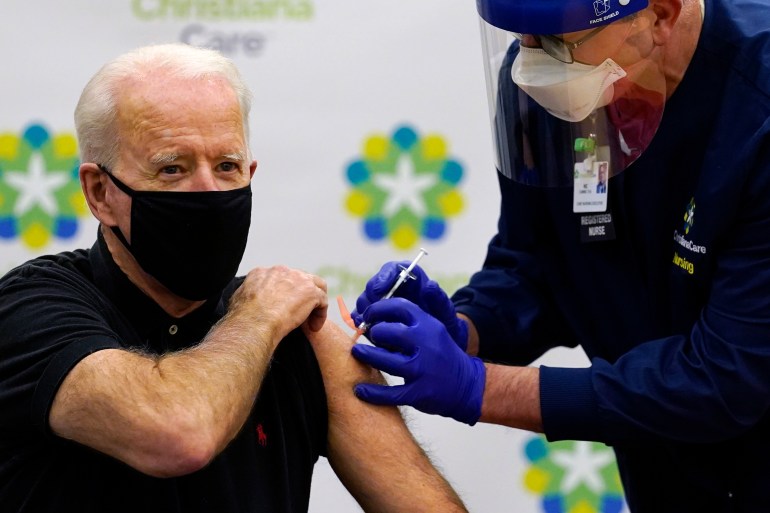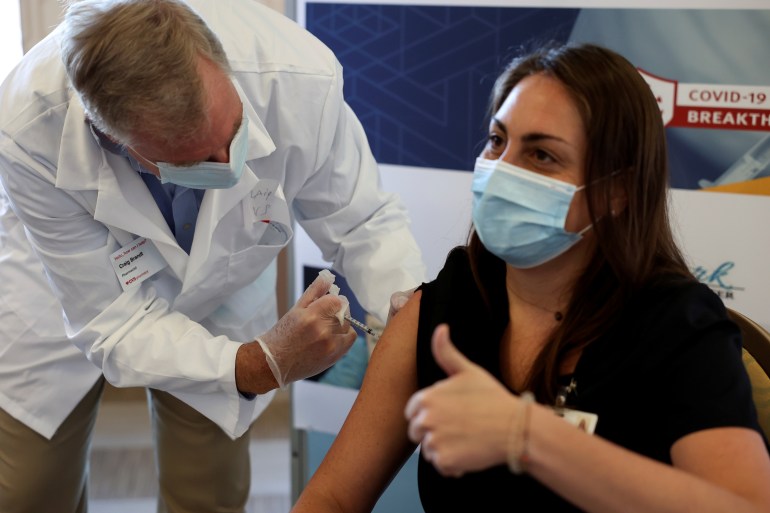US to release millions of doses to speed up COVID vaccinations
The move aligns with the incoming Biden administration strategy to quickly release most vaccine doses.

Barely a month into a mass vaccination campaign to stop the COVID-19 pandemic, the Trump administration unexpectedly shifted gears on Tuesday to speed up the delivery of shots after a slow start that had triggered widespread concern from states and public health officials.
Health and Human Services Secretary Alex Azar announced two major changes. First, the government will no longer hold back required second doses of the Pfizer-BioNTech and Moderna vaccines, practically doubling supply. Second, states should immediately start vaccinating other groups lower down the priority scale, including people age 65 and older, and younger people with certain health problems.

The move better aligns the outgoing administration with the new Biden-Harris team. On Friday, President-elect Joe Biden said he will rapidly release most available vaccine doses to protect more people. He said he supported immediately releasing vaccines that health authorities were holding back out of caution, to guarantee they would be available for people needing their second dose.
“We had been holding back second doses as a safety stock,” Azar told ABC News. “We now believe that our manufacturing is predictable enough that we can ensure second doses are available for people from ongoing production. So everything is now available to our states and our health care providers.”
Keep reading
list of 3 itemsUS vaccine roll-out falls short of 20 million jabs by end of 2020
COVID: BioNTech founders warn of vaccine supply gaps
Simultaneously, he gave states the green light to dramatically expand the pool of people eligible to receive vaccines.
“We are calling on our governors to now vaccinate people aged 65 and over, and under age 65 with a (health condition) because we have got to expand the group,” he said.
As of Monday morning, the government had distributed about 25.5 million doses to states, US territories and major cities. But only about 9 million people had received their first shot. That means only about 35 percent of the available vaccines had been administered.

Initially, the shots were going to health care workers and nursing home residents. Those 75 and older were next in line. But problems arose even in vaccinating that limited pool of people. Some hospital and nursing home workers have been hesitant to get the vaccine. Scheduling issues created delays in getting shots to nursing homes.
“We’ve got to get to more channels of administration,” said Azar. “We’ve got to get it to pharmacies, get it to community health centres.”
“We will deploy teams to support states doing mass vaccination efforts if they wish to do so,” he added.
Although Azar said the shift was a natural evolution of the Trump administration’s efforts, as recently as Friday he had raised questions about whether Biden’s call to accelerate supplies was prudent.
Each state has its own plan for who should be vaccinated, based on recommendations from the federal Centers for Disease Control and Prevention. The CDC recommendations give first priority to health care workers and nursing home residents.
But the slow pace of the vaccine roll-out has frustrated many Americans at a time when the coronavirus death toll has continued to rise. More than 376,000 people have died, according to the Johns Hopkins database.
The new strategy would require that Pfizer and Moderna, makers of the first two coronavirus vaccines authorised for use in the US, are able to maintain a consistent supply so second shots could still be administered on schedule.
The Pfizer-BioNTech vaccine requires a second shot about three weeks after the first vaccination. Moderna requires a second shot about four weeks afterwards. One-shot vaccines are still undergoing testing.